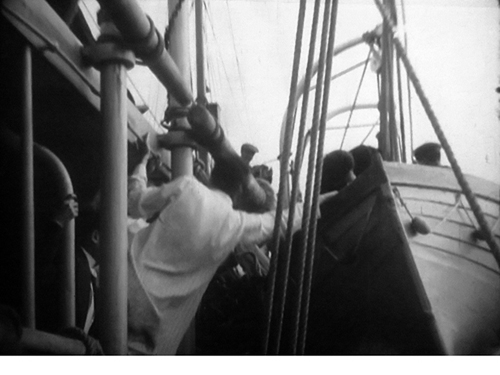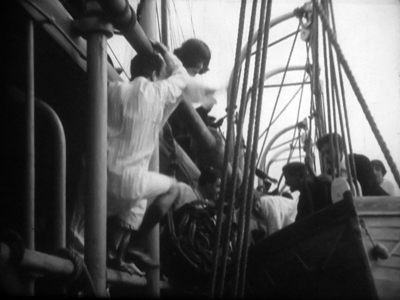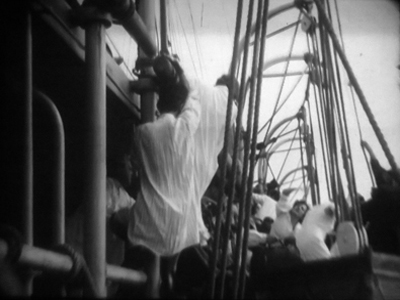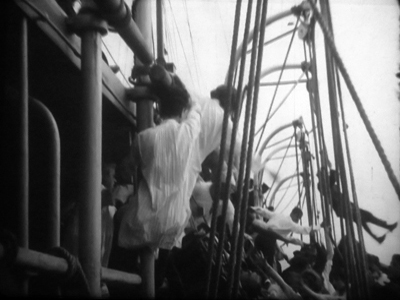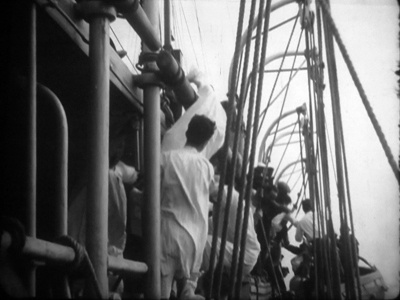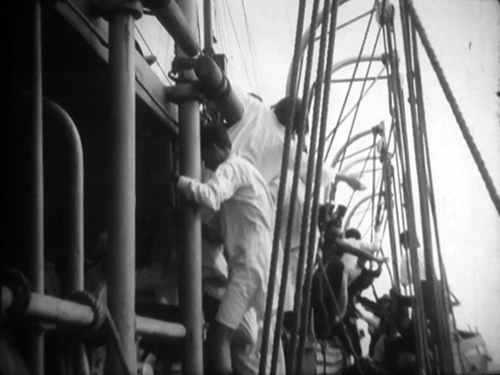Sometimes a shot . . .
Wednesday | July 25, 2012 open printable version
open printable version
I Topi Grigi, Chapter 6: Aristocrazia Canaglia.
DB here:
… just knocks you out.
In wrapping up my stay at the Royal Film Archive of Belgium, where I concentrated mostly on German films of the late 1910s and early 1920s, I watched a copy of I Topi Grigi (“The Gray Rats”), a 1918 Italian serial. It’s part of an immense series devoted to the adventures of the cadaverous rogue Za La Mort. Directed by and starring the fascinating Emilio Ghione, it’s in the vein of Fantômas and Les Vampires, though I don’t find it as ingenious or funny or as skillfully directed as Feuillade’s masterpieces.
But then you get those moments. Za La Mort and his young charge Leo are aboard an ocean liner when it’s struck by a torpedo. The passengers panic and make for the lifeboats. It ought to be a spectacular scene reminiscent of Atlantis (1913), but there aren’t many shots devoted to this climax. We see only a few images of people rushing up to the deck from their cabins. The central shot showing the crisis is an image slung along the side of the ship, down the row of lifeboats as people scramble into them. The shot is interrupted by glimpses of men climbing the masts and survivors in the water, but this camera setup is the only one concentrating on the process of getting people offboard.
At first we’re looking down the row of boats, but, as you can tell from my top image, we can’t see much of anything–mostly a man in a nightshirt grabbing the hull of a lifeboat. Then, as the boat is lowered and he has to pull back, we get to see a lot more. Into the slot formed by the lifeboat supports, crisscrossed by ropes and rigging, slip faces and bits of bodies. A woman stoops, a man in silhouette shouts. Meanwhile, a dark-haired woman leans over the railing.
While our young man in the nightshirt sways precariously, the boat continues to descend and we can see even further down the row of lifeboats. A woman in the middle distance calls out. The woman at the railing has started to crawl down the side of the ship.
Now, in the depth of the shot, people are seen trying in vain to pile into the boats. Abruptly, a man on a rope swings into the shot.
The boats are edging away from the ship’s hull–a slight gap emerges in the distance–but we can see passengers still shoving to try to board them.
It’s over for these people. The lifeboats descend, the boy in the nightshirt is still stranded on the side, and the woman who has climbed down beside him vainly stretches out her arm. (See below.)
A new video essay from Flavorpill offers you “135 shots that restore your faith in cinema.” It’s mostly a collection of purty pitchers laced with emblematic moments from classics. But probably you, like me the day before yesterday, haven’t seen Topi Grigi, so my images offer no cosy film-nerd nostalgia. And compared to the Hallmark-Cards aesthetic on display in most of the video essay’s clips, this shot is pretty messy.
But it engages your vision in a dynamic way. It coaxes you to watch a process, in all its scrambling disorder, along a line of sight that emerges, gradually, as uncannily precise. Desperate faces and gestures cascade through a rigid geometry–frames within frames, receding arches like ribbing in a vault, taut diagonals slicing across the frame. Would I trade this concise, rousing, remorseless stream of images for the last forty minutes of Titanic? Yes.
Joseph North offers an admirably detailed chronology and contextualization of the series in his 2011 Masters Thesis, Emilio Ghione and the Mask of Za La Mort. It’s available as a pdf here. Thanks as well to Edward Branigan for alerting me to the Flavorpill video.












